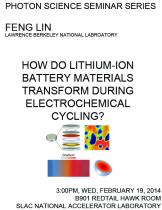Speaker: Feng Lin, Enviornmental Energy Technologies Division, Lawrence Berkeley National Laboratory
The present study is targeted to understand the characteristics of phase transition and chemical evolution in lithium-ion battery materials. The study was conducted using in-depth electrochemical diagnostics, nanoscale-to-macroscale core-level spectroscopies as well as atomic resolution electron imaging. We reconstructed the 3D architecture of the lithiation/delithiation fronts for anode materials and found that heterogeneous phase nucleation prevails in the battery conversion reactions. Moreover, we investigated the structural evolution in prominent LiNixMnxCo1-2xO2 cathode materials under high-voltage operation conditions, and determined that the anisotropic phase transition from an R3 ̅m structure to an Fm3 ̅m structure at the surface of LiNixMnxCo1-2xO2 particles is primarily responsible for performance degradation. This work sets a refined example for investigating battery materials using correlated core-level spectroscopies at complementary length scales.





